What Are the Measurements to Draw Floor Plans to Scale
- Habitation
- How to Read Firm Plans
- Scale for Floor Plans
Scale for Floor Plans
Past Meg Escott
Understanding scale for floor plans is a really useful skill when you're building or remodeling your abode.
Calibration drawings are an indispensable function of your building or remodeling home projection. You'll demand to be able to read them to understand and give your approval for the design of your new abode.
The focus of this page is on using scale to read floor plans. Check out how to describe flooring plans for a discussion on using scale if you're drawing your own flooring plan.
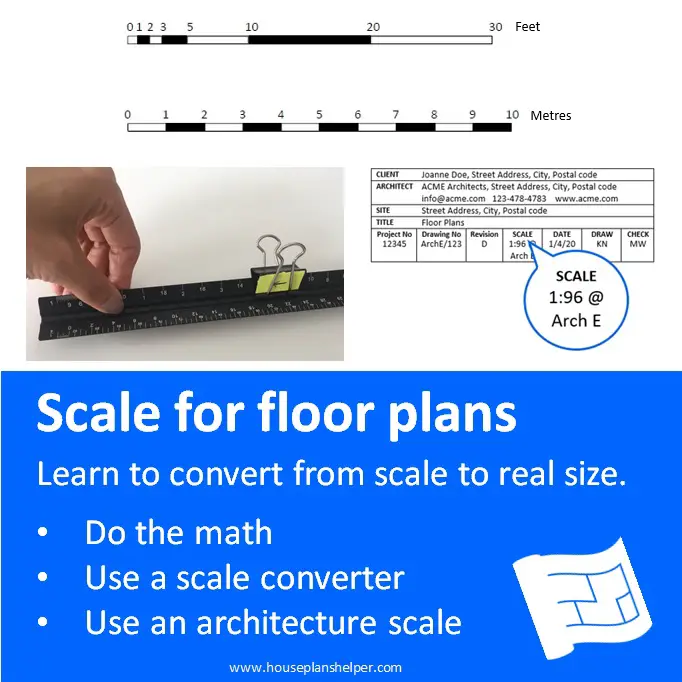
This page forms part of the how to read firm plans series.
On this page we'll cover...
- What units of mensurate is my floor plan using?
- What scale is my floor plan using?
- Printing your floor plan to the correct scale
- Figure out the existent size of something on your floor plan
Before nosotros get started on scale for floor plans, we need commencement to talk about units.
What units of measure is my floor plan using?
The first thing to effigy out is if the scale on your floor plan relates to anxiety and inches (the imperial system) or relates to millimeters, centimeters and meters (the metric system).
This usually depends on the region of your home. If you're in the US yous're likely to be working in the imperial system. If you're in the UK, Ireland or Australia, information technology'south probably the metric system. Canada is a chip of a mix but usually metric.
Before you lot go any further, figure out what organisation, imperial or metric, your drawings are using. Look to run across what units the dimensions on the flooring program are marked in.
What scale is my floor programme using?
If your floor programme has a title block, the calibration should be indicated in that location. It should tell yous what the scale is for a particular newspaper size.
The calibration for floor plans tin can exist shown in 2 different ways:
- As equivalent measurements, eg i/8" = i' or 1cm = 1m, "an eighth of an inch represents 1 foot" or "1cm represents 1m"
- As a ratio eg 1:96 or 1:100, "i to forty 8" or "one to i hundred"
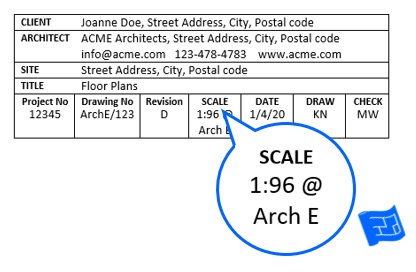 This title block is saying the drawing is to scale 1:96 when printed on Arch Due east newspaper
This title block is saying the drawing is to scale 1:96 when printed on Arch Due east newspaper
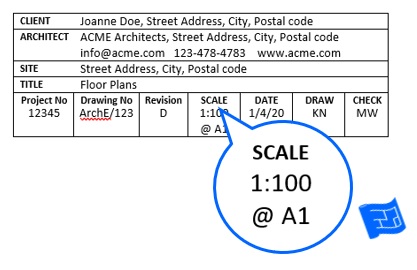 This title block is saying the drawing is to scale i:100 when printed on A1 paper
This title block is saying the drawing is to scale i:100 when printed on A1 paper
Common scales for imperial floor plans (anxiety and inches)
- 1/4 inch to a foot which means 1 inch on the paper represents 48 inches in real size (i:48).
- 1/8 inch to a foot which means i inch on the paper represents 96 inches in existent size (one:96).
- 1/16 inch to a pes which means 1 inch on the paper represents 192 inches in existent size (1:192).
Common scales for metric floor plans (mm, cm, m)
- 2cm to 1m which means 2cm on the newspaper represents 100cm (or 1m) in real size (1:50).
- 1cm to 1m which means 1cm on the paper represents 1oocm (or 1m) in real size (i:100).
- 1cm to 2m which means 1cm on the paper represents 200cm (or 2m) in real size (ane:200).
Architects tend to work in millimeters, but this doesn't alter the meaning of the scales in a higher place. For example, using the scale one:100, saying 1mm represents 100mm is the same equally saying 1cm represents 100cm.
No scale in the title cake? Look for a calibration bar
If at that place'south no title block, another mode to discover the scale for floor plans is to look for a scale bar.
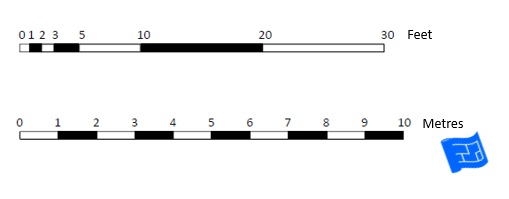 Examples of scale confined. Top is imperial, bottom is metric.
Examples of scale confined. Top is imperial, bottom is metric.
Working out the calibration from an purple scale bar
Hither's what you need to do to work out the calibration from the calibration bar:
Mensurate the length of the scale bar - we're looking at the height bar and let's say it measures 3 three/four inches.
This tells united states that 3 three/four inches (or 3.75 inches) represents 30 pes (the length of the bar).
30 foot = 30 ten 12 = 360 inches.
And so we now know that 3.75 inches represents 360 inches.
And then 1 inch represents (360 / 3.75) = 96 inches.
Y'all tin run across above that we need to catechumen fractions of inches into decimals. To brand that a bit easier I've written them out here.
Working out the calibration from a metric calibration bar
Measure the length of the scale bar - for the bottom bar, allow's say it measures 10cm.
This tells us that 10cm represents 10m.
And then 1 cm represents (x / 10) = 1m.
Much simpler for the metric system!

What if there's no calibration for the floor program?
If you're looking at a flooring plan with no scale or dimensions marked here's a trick. If the kitchen is marked in the floor program, a standard kitchen countertop is 2ft or 60cm deep. So if yous mensurate how deep the countertop is on the plan, that's what 2ft or 60cm is equivalent to.
To calculate what 1ft in real life is on the plan, divide the kitchen countertop measurement on the plan by 2.
To calculate what 1m in real life is on the program, divide the kitchen countertop measurement past 60, then multiply past 100.
This will requite you lot a rough idea of the dimensions and scale that y'all're dealing with on the floor plan.
Printing your floor plan to the right calibration
When yous're reading a floor plan yous might exist able to get near of what you want to know by looking at the floor plan on screen.
If you want to take accurate measurements your best bet is to get a print out of your flooring plan. If you lot're looking at drawings that are meant to be printed on big format paper, this tin can pose a problem because it'south unlikely yous've got easy access to a big format printer.
Here's a few options for getting a print out of your floor programme.
- Inquire your builder or design professional to provide you with a gear up of drawings printed out.
- Send your drawings to a printer/graphics store - check that they have a printer big enough to handle the paper size before you ship the files.
- Print out a department of the floor plan to scale onto a size of paper that's convenient for the printer you have access to. Print a section of a pdf floor programme to calibration.
Figure out the real size of something on a flooring program
OK, so you know what units you're working in, and you lot know what the scale for floor plans is, you're ready to use calibration conversion to effigy out the real life size of something on your floor plan.
At that place are two options for this:
- Using a uncomplicated ruler and doing a bit of maths.
- Using an architectural scale
Scale conversions
Let's do a few examples of calibration conversions.
Scale for flooring plans regal conversion instance...
Let's say we're looking at a floor plan and the scale is 1:48.
Nosotros measure out the length and width of the open plan living space on the floor plan.
- Flooring program length = 9 and 1/8th inches or 9.125 inches
- Floor program width = 3 and 1/8th inches or 3.125 inches
- Real size length = (3.125 x 48) = 150 inches or 12 foot half dozen inches
- Real size width = (9.125 x 48) = 438 inches or 36 foot 6 inches
Y'all might find this table to convert fractions of inches to decimals useful.

Top tip
Conversion in imperial scales takes quite a few taps on a calculator, and information technology's not much better on the majority of online calibration converters. I've gear up upward some super quick, minimum click majestic scale converters that are available to HPH members. Find out how to bring together.
Scale for floor plans metric conversion case...
Allow's say nosotros're looking at a floor plan and the scale is 1:50.
We measure the length and width of the bedroom on the flooring plan.
Floor plan length and width (square room) = 6.8cm
Real size length and width = (half-dozen.8 x fifty) = 340cm or 3.4m

Check that the calibration conversion makes sense
Once you lot've done a scale conversion calculation just have a recollect to make certain it makes sense. Is your reply roughly what you lot expected it to be?
Using an architectural scale
Let'south have a expect at how to measure out on a floor programme using an architectural scale.
The beauty of an using an architects calibration to read scale for flooring plans is that you don't need to do calculations to measure dimensions on your flooring program.
There's a great video to explain how to use an architect'due south scale...

A tip for using your architect's calibration
Builder'southward scales accept several scales and if y'all put your architects calibration down it can be like shooting fish in a barrel to lose track of where the scale y'all're using is.
Try putting a clip on your scale with a slice of paper with an pointer towards the nil of the scale you're using. This makes information technology very quick to get right back to where y'all need to be with your architects scale.
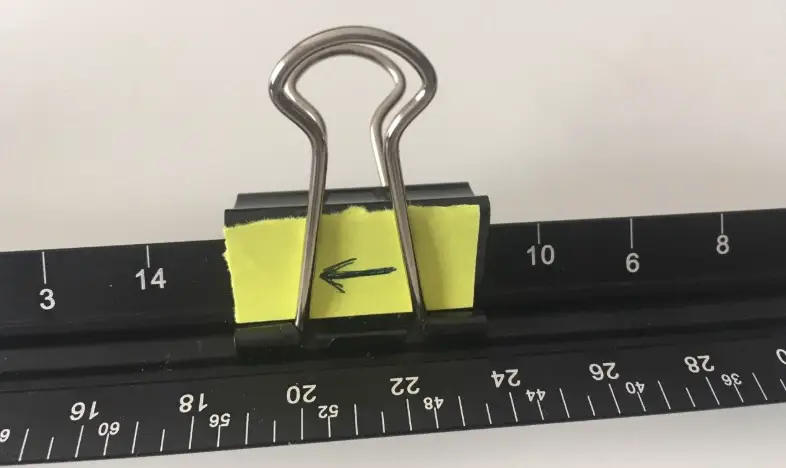
Y'all tin run across how this prune is pointing towards the zero on the 1/4 inch to 1 foot scale.
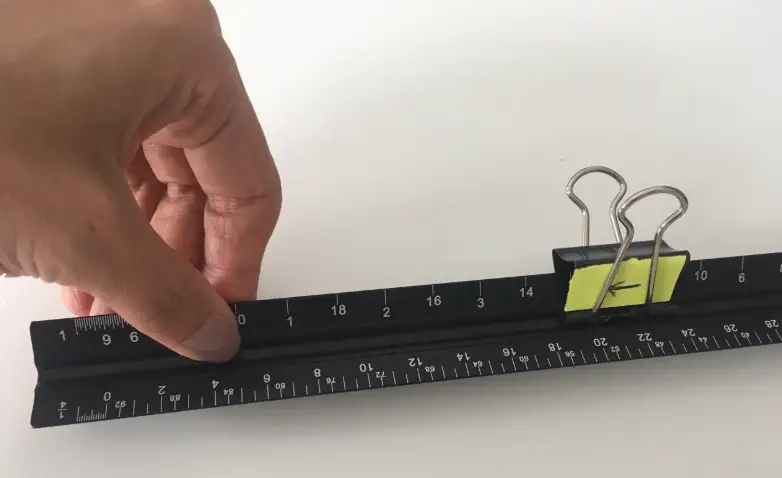
More on How to Read House Plans
Converting fractions of inches to decimals
1/2 inch
| Length in inches | Decimal equivalent |
|---|---|
| 1/2 inch | 0.5 |
1/4 inch
| Length in inches | Decimal equivalent |
|---|---|
| 1/4 inch | 0.25 |
| 2/4 inch (aforementioned equally ane/ii inch) | 0.five |
| iii/4 inch | 0.75 |
1/8 inch
| Length in inches | Decimal equivalent |
|---|---|
| i/8 inch | 0.25 |
| 2/eight inch (same equally 1/iv inch) | 0.25 |
| three/8 inch | 0.375 |
| 4/8 inch (same as one/2 inch) | 0.5 |
| 5/viii inch | 0.625 |
| 6/8 inch (same equally 3/4 inch) | 0.75 |
| 7/eight inch | 0.875 |
1/xvi inch
| Length in inches | Decimal equivalent |
|---|---|
| 1/16 inch | 0.0625 |
| two/16 inch (same equally 1/viii inch) | 0.125 |
| iii/16 inch | 0.1875 |
| 4/16 inch (same equally 1/4 inch) | 0.25 |
| 5/sixteen inch | 0.3125 |
| 6/sixteen inch (same as 3/viii inch) | 0.375 |
| 7/16 inch | 0.4375 |
| 8/16 inch (same as i/2 inch) | 0.5 |
| 9/xvi inch | 0.5625 |
| x/16 inch (same as 5/viii inch) | 0.625 |
| 11/xvi inch | 0.6825 |
| 12/sixteen inch (same equally three/4 inch) | 0.75 |
| 13/16 inch | 0.8125 |
| xiv/sixteen inch (same every bit 7/8 inch) | 0.875 |
| fifteen/16 inch | 0.9375 |
Source: https://www.houseplanshelper.com/scale-for-floor-plans.html
0 Response to "What Are the Measurements to Draw Floor Plans to Scale"
Post a Comment